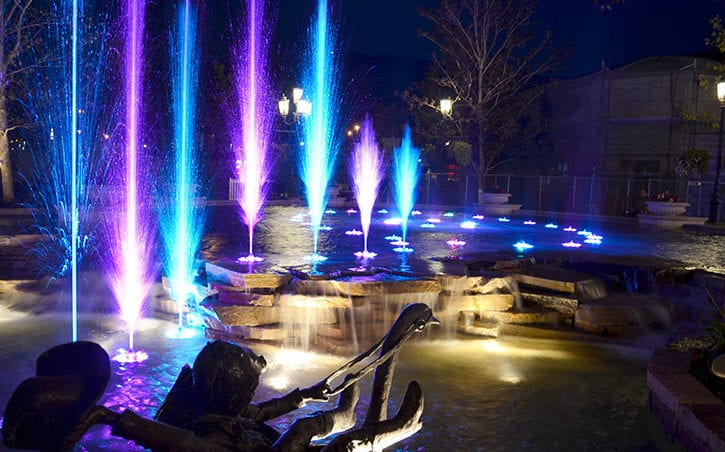Foundation to Fountain: The Nuts and Bolts of Water Features
Posted in Insights -

3 Questions with Chris Roy, Director of Creative Design, OTL, Inc.
1. What are the materials and/or components used to begin building a water feature?
Most architectural water features are built using a reinforced concrete structure. Just as with a building, proper testing and preparation of the foundation is very important. Water is heavy, and the grade or structure below a fountain must be engineered to support a load that is able to move, be drained away, and refilled time and again.
“
The foundation of a water fountain should be built under the engineer’s direction depending on soil reports and may need additional preparation to ensure suitable construction for a fountain.
” Chris Roy, Director of Creative Design for OTL.
While water feature designs vary greatly, some form of a basin is almost always an essential component. These water-holding vessels are most often coated with a waterproof membrane meant to seal the basin, essentially making it watertight. This is why the fountain’s concrete work must be smooth and free of any defects when the surface coating is applied.
2. What is the best way to keep a fountain from leaking or corroding?
We prefer to use a higher strength concrete for our fountains because it’s watertight and not as porous. We’ve seen some water feature basins constructed using concrete blocks, which is never a good idea. Blocks are full of joints and the rough, porous texture is difficult to waterproof. In addition, construction joints in water basins should be kept to a minimum and must be carefully constructed to avoid leaking.
The use of continuous waterstops are also important to prevent water infiltration and protect the steel reinforcing bars from corrosion. Utilizing stainless steel dowels across construction joints instead of standard steel rebar is best. Waterstops should be placed within the wall on the ‘wet side’ of the concrete so they prevent moisture from corroding the reinforcing bar.
There are a variety of waterstops available, but we prefer to use swelling-style waterstops depending on the thickness of the wall. These are manufactured using bentonite clay and are designed to adhere and expand within a joint to fill any void when activated by water.
For a more in-dept dive into the technical aspects of waterstops and construction joints, please visit Fountain Structure
3. Are there other technical challenges that go into constructing a water feature?
One of the fountain-specific details that we sometimes make allowances for are mechanical items such as skimmers. A typical front-access skimmer needs a 10-inch minimum wall thickness for adequate concrete coverage over the back. Depending on the aesthetics of the fountain and the location of the skimmer, this may necessitate using a 10-inch basin overall or increasing the thickness of the wall.
Thinner walls present a challenge all their own and are typically requested for purely aesthetic reasons. While we generally recommend not building basin walls thinner than 6”, there are special construction methods that we can use in specific cases, which have to be carefully designed and engineered on a case-by-case basis.
One of the other technical challenges we’re faced with on a regular basis is construction of fountains on decks above parking garages and/or occupied space. Ensuring that these fountains don’t leak is doubly important, and waterproofing is typically detailed as a “belt-and-suspenders” system, with architectural waterproofing on the deck, as well as fountain waterproofing in the basin.
This construction requires close coordination between the fountain designers and builders, the project architects and structural engineers, and the project waterproofing subcontractor tasked with sealing the structural slab. The fountain’s concrete structure needs to be anchored to the structural slab, which means penetrating the architectural waterproofing. The different trades involved must coordinate installation to ensure that all penetrations are properly sealed so that all parties are able to deliver complete, warrantable systems to the owner.
For a more in-depth dive into the technical aspects of rebar and other reinforcing materials, please visit Fountain Structure
As you can see, there are a lot of details that go into the structural design of water features. Staying abreast of different building techniques and materials are what allow us to design high quality water features that are more efficient and longer lasting for our clients.

Chris Roy is the Director of Creative Design for Outside the Lines, Inc. In this role, he leads the company’s design efforts, working with developers, architects, and landscape architects, as well as engineers and vendors. Contact him at ChrisR@otl-inc.com.
Featured Articles
- Getting to Know OTL’s Administrative/Accounting Assistant Nathan Touche
- Centers With Well-Designed Experiential Water Features Can Attract 30,000 Visitors Per Week
- AI and Facility Management: How to Avoid Potential Pitfalls
- From Cancer to Racecar Driver: The Amazing Story of Gabe Tesch
- OTL’s Sarah Shores to Speak on Women in Construction Panel